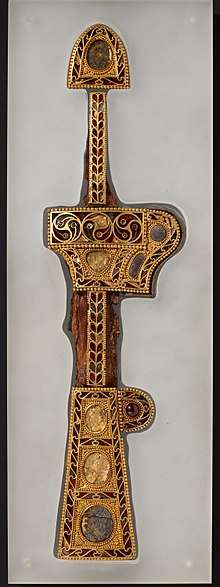Gyerim-ro dagger and sheath
The Gyerim-ro Dagger and Sheath are ornately decorated treasures that were excavated from an ancient Korean tomb from the Silla Kingdom (57 BCE – 935 CE) in 1973. They are understood to originate from the Black Sea area, testifying to the expansiveness of the Silk Road network in the ancient world.

Description
The dagger and sheath are made up of gold, decorated with elaborate, colorful glass and garnet jewel inlays. The treasure is 14 1/8 in. (36 cm) in length and belongs to the Gyeongju National Museum of Korea. It is listed as Korea’s Treasure No. 635.
History
The Gyerim-ro Dagger and Sheath were excavated from the Gyerim-ro Tomb No. 14 in 1973 in North Gyeongsang Province. The dagger is understood to have originated from the Black Sea area of Central Asia sometime during the 5th century, coming to Korea through trade or as a diplomatic gift. This was determined by comparing the dagger and sheath to other items of similar constructor depiction (through wall paintings and fragments).[1] The dagger has a decorative and functional head at the end of the handle and the sheath has two side appendages. These were used to attach the dagger to the carrier’s belt, from which it hung horizontally.[2]
A deeper understanding of this double-appendage suspension system supports the theory that the Hephthalite invasion of Central Asia brought with it an introduction of the two-point hanging system to (as seen in the Gyerim-ro dagger and sheath), which has since become recognizable as the Eastern Eurasian dagger and sword suspension systems that was carried on from Central Asia to China.[3] The two-point suspension system's arrival in China is likely a result of the Silk Road. Vast scholarship on the Silk Road informs that trade between Central Asia and East Asia was affluent and thriving during the 5th century, and thus the occurrence of a Black Sea area item in a Korean tomb should not come as a surprise.
Influence
Choe Kwang-shik argues that Northern and Western influences are found in Silla art, specifically those from the Scythian nomadic peoples, which provided a direct link between Silla and the coastal area of the Black Sea.[4] Other examples of Scythian influence on the Silla Kingdom include the Bronze Horse-Shaped Buckle and the Silla Crowns. These contain animal motifs characteristic of Scythian art. Korea's connection to the Scythian peoples. This demonstrates Korea's involvement with the Silk Road and provides an explanation for the value of placing a dagger and sheath in a tomb.[4] The Gyerim-ro Dagger and Sheath were likely symbols of social class and the achievements of the person who wore them. Similar to the Sutton Hoo burial site, the purpose of laying someone to rest with their treasured weapon was to signify worth and aspirations for life after death.
References
- "Imported Luxuries and Exotic Imagery". www.metmuseum.org.
- "A Dagger and Gold Scabbard from the West: The Excavation of Gyerim-ro Tomb No. 14, Gyeongju | Current Exhibitions". NATIONAL MUSEUM OF KOREA. Archived from the original on 2018-12-06. Retrieved 2018-11-22.
- Kagayama, Etsuko (2016). "Change of suspension systems of daggers and swords in eastern Eurasia: Its relation to the Hephthalite occupation of Central Asia" (PDF). Institute for Research in the Humanities Kyoto University. 46: 199–212 – via ZINBUN.
- Choe, Kwangshik (2014). "Silla Art and the Silk Road" (PDF). International Journal of Korean History. 19: 1–22.